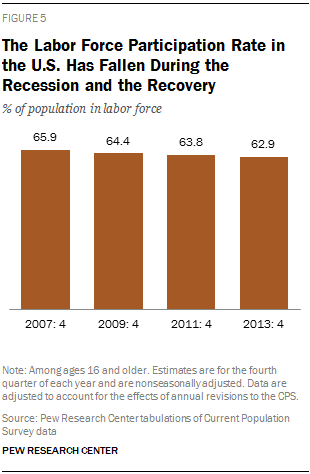The jobs recovery still lacks momentum: The economy has not restored all of the jobs that were lost in the recession and is adding new jobs at a pace that is barely keeping ahead of the additional supply of workers. At the end of 2013, all major labor market indicators, such as employment and unemployment rates, trailed their pre-recession levels.
Some 7.7 million jobs were lost during the Great Recession, from the fourth quarter of 2007 to the fourth quarter of 2009. Four years hence, through the fourth quarter of 2013, the economy has restored only 6.4 million of those jobs as the process of hiring has been slow but steady.7 Some 3.3 million jobs were added from 2009 to 2011 and 3.1 million more were added from 2011 to 2013.8

The rate at which jobs are returning is only slightly ahead of the rate at which the working-age population is growing. From 2009 to 2013, the working-age population increased by 9.2 million and the economy added 6.4 million jobs. In percentage terms, the population increased 3.9% and employment increased 4.6%. As a result, the employment rate, or the share of the working-age population that is employed, was only a bit higher in 2013 than at the end of 2009—58.7% compared with 58.2%. It remains several percentage points less than the pre-recession employment rate of 62.8% in the fourth quarter of 2007.
 The number of Americans unemployed has fallen in the recovery, from 14.7 million in the fourth quarter of 2009 to 10.4 million in the fourth quarter of 2013. But that is still 3.3 million more than the 7.1 million who were unemployed in the fourth quarter of 2007. Even though the recovery has pushed the unemployment rate down from 9.6% in 2009 to 6.7% in 2013, it remains higher than the pre-recession rate of 4.6% in late 2007.
The number of Americans unemployed has fallen in the recovery, from 14.7 million in the fourth quarter of 2009 to 10.4 million in the fourth quarter of 2013. But that is still 3.3 million more than the 7.1 million who were unemployed in the fourth quarter of 2007. Even though the recovery has pushed the unemployment rate down from 9.6% in 2009 to 6.7% in 2013, it remains higher than the pre-recession rate of 4.6% in late 2007.
Perhaps not all of the decrease in the unemployment rate from 2009 to 2013 can be credited to the economy recovery. Some of it may be due to people leaving the labor force because they are discouraged by not being able to find work. People who stop looking for work are not counted as unemployed. The trend in the labor force participation rate—the share of the working-age population that is working or looking for work—supports this hypothesis as it has fallen even during the recovery, from 64.4% in 2009 to 62.9% in 2013.9


